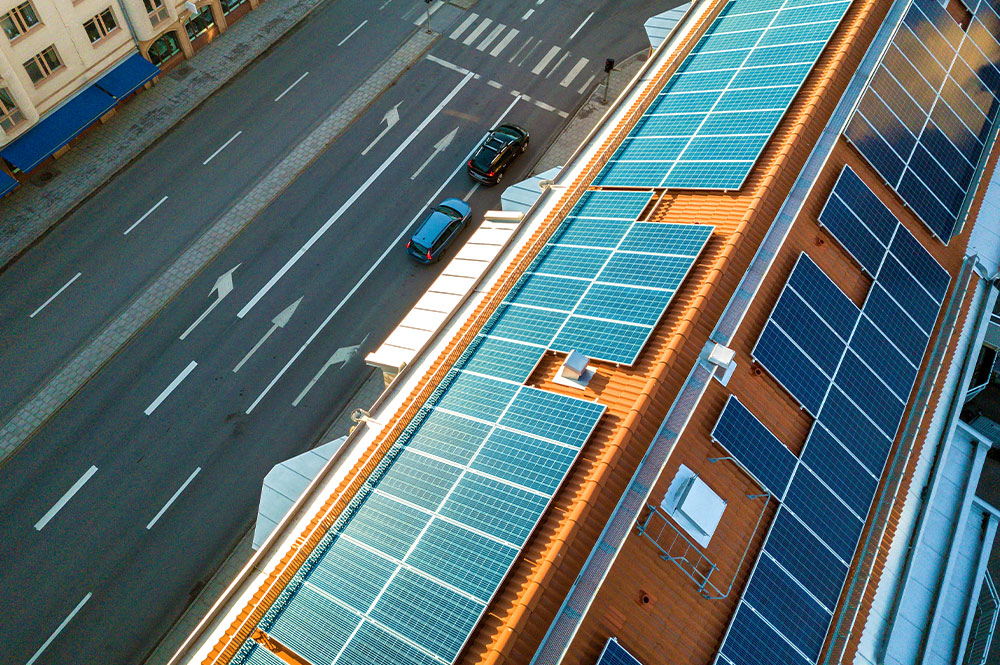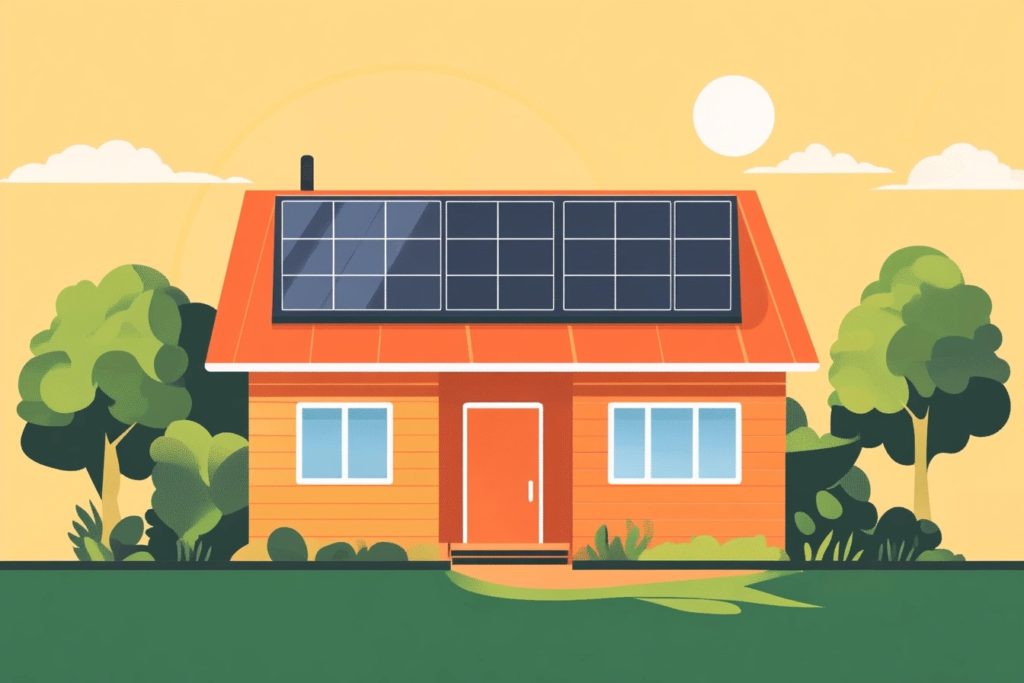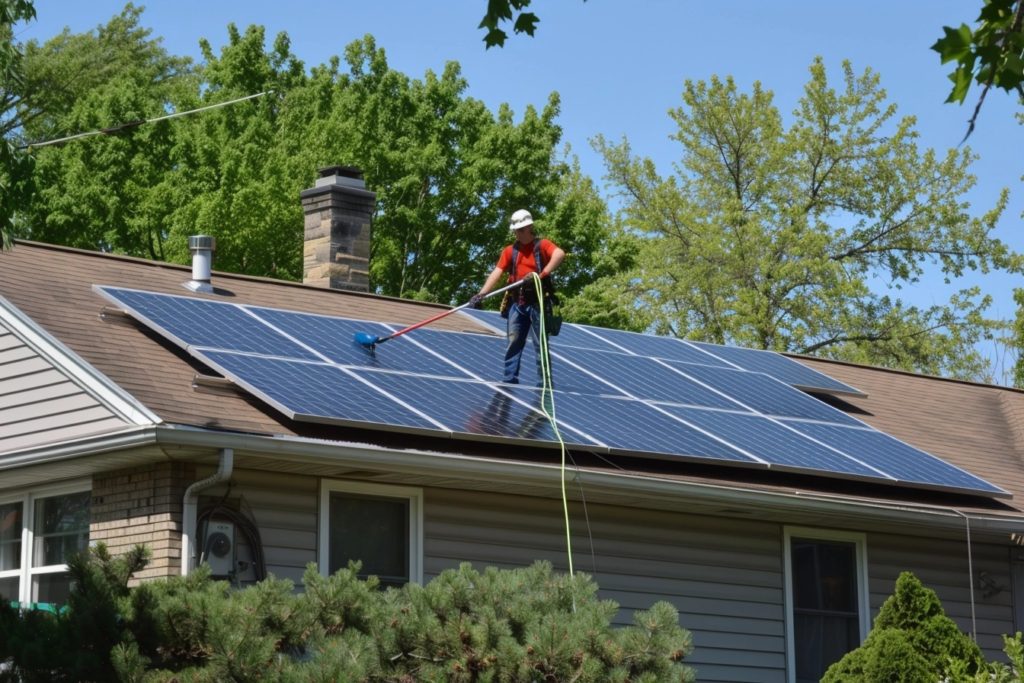
What are rooftop solar panels?
A rooftop solar panel is a grid that acts as a “collector” of the sun’s radiant energy, converting it to usable energy that is then stored in batteries and later used to power our homes. The solar cells within the grid are also called photovoltaic cells and are responsible for collecting radiant energy. The panels (modules) are grouped into “arrays” and placed in large outdoor spaces or rooftops. The number of PV cells needed for an array depends on the size of the module, i.e., a 12V module has 36 PV cells, while a 24V module has 72 PV cells.
Solar technology uses crystalline silicon as its semiconducting material. In residential rooftop solar panels, this material is monocrystalline or polycrystalline silicon. The silicon’s purity determines the efficiency of a solar panel. Monocrystalline is purer than polycrystalline silicon, so it generates more power with less space. There are other types of modules available, most of them not suitable for home installation.
How do rooftop solar panels work?
The sun can be compared to a natural nuclear reactor. It is constantly releasing tiny particles of electromagnetic radiation (EMR) energy called photons. Rooftop solar panels collect the photons within the PV cells, converting the EMR into usable electricity. Solar energy is converted to direct current (DC), which is ultimately converted to alternating current (AC) that we use for power.
In this article, we discuss the lighter side of science on how rooftop solar panels work.
PV Cells—turning photons into electrons
As mentioned earlier, PV cells convert energy from the sun into electrical energy. Solar cells are constructed from semiconducting materials, most often silicon (Si), one of the most plentiful materials in the world. During this photovoltaic process, photons are turned into electrons.
One of the most significant benefits of this conversion process is that it does not generate any harmful emissions or waste, thus maintaining a clean, green environment while being extremely effective at generating energy. Photovoltaic cells (solar cells) are semiconductor devices that produce DC electricity when light falls on them.
Rooftop Solar panels—generating current
We discussed how PV cells convert photons into a direct current (DC). Each solar cell is made from crystalline silicon “sandwiched” between a negative and positive conductive layer. The positive layer has extra space, while the negative layer has excess electrons. Keep in mind that electrons move from negative to positive. Electrons travel across the confluence of the two layers, leaving a negative charge on one side and a positive charge on the other.
Because each cell produces about .5V, modules are constructed using several PV cells to generate enough electricity to power a house. It takes 12 PV cells to charge your cell phone—powering a home takes several modules.
If they could utilize an expanded range of convertible wavelengths, rooftop solar panels would generate more energy. Silicon, the semiconductor used in photovoltaic cells, does exceptionally well converting some of light’s wavelengths into electricity. The range of wavelengths a semiconductor can convert depends entirely upon the electrical properties of the material. If these materials absorb wavelengths packing more energy than those in the specific range of the material, the excess energy is lost as heat. Advancement in solar power technology is focused on increasing silicon solar cell efficiency by developing materials that can capture a broader range of wavelengths.
Inverters—DC to AC
Rooftop solar panels are incapable of powering a home—they need an inverter to convert the currents into usable electricity. The panels generate direct current (DC). Most houses in the US are wired for AC power. Therefore, an inverter is used to transform the DC into an alternating current (AC). A small, minuscule amount of energy may be lost in this conversion.
Most solar energy systems have a single inverter for the entire home. Another option is to connect microinverters to each panel. Either way, the result is the same.
Electricity is now available
AC electricity flows from the inverter to an external circuit and through your home. The solar-generated electricity then flows to all your home’s appliances, computers, TVs just as it would if you were receiving it from the power company. Rooftop solar panels may produce more power than your family needs. In that case, it can be stored in specialized batteries or sold back to the power company. Depending on how you get set up with the local power company, if your batteries are running low, you may be able to return to the power grid for the short term, for which you may receive a bill. Every power company has different programs for excess power buy-back and requirements for returning to the grid.
Excess energy—should you sell it or store it?
Suppose your rooftop solar panels generate excess energy. In that case, you have the option of either storing it in solar batteries or selling it through a net metering program back to the local utility company. By keeping the excess energy in solar batteries, your system remains off the grid. Batteries also provide you access to power 24/7, even on cloudy days when your rooftop solar panels don’t generate electricity quite as efficiently.
If you decide to use net metering, the utility company will pay you for the power you sell them. Depending on how the local utility company’s program is structured, they may apply for the compensation as bill credits, which can help offset any electricity you may use if you access the grid, helping you save money. Utility companies won’t pay cash for supplying power into the grid.
What is the lifespan of rooftop solar panels?
Rooftop solar panels can last up to 25 years or more—they are surprisingly durable and require little to no maintenance. There are no mechanical or electronic parts, so there is no wear and tear, and nothing gets worn down.
Solar panel manufacturers forecast a degradation rate of about 0.8% per year. After 20 years, solar energy production should only drop to an estimated 84% of the efficiency standard.
Residential panels typically come with performance warranties of 10-25 years. Depending on where your home is located, your system may outlive its warranty. Some rooftop solar panels continue to function for 40 years at a relatively high rate of efficiency. Panels can withstand 140 miles per hour wind speeds, according to Energy Sage. Most homeowners’ insurance policies cover solar panels against damages.
What is the lifespan of solar batteries?
Solar batteries and PV inverters don’t last as long as solar panels. Typically, solar PV inverters last between 10-15 years; the possibility of replacing them both within your system’s lifespan is very likely. A quality solar battery can be expected to last 8-15 years.
Inverter and battery inverter performance can be expected to decline over time. When comparing the different types of rooftop solar energy systems, be sure to read the warranty and performance guarantee.
Will solar power save me money?
Yes. Most Americans who have installed solar panels save on their electric bills. To better understand if solar panels will save you money, once you calculate or get a quote for the system, figure out your breakeven period:
- How much do you spend annually on electricity?
- How much will the system cost?
- Divide the total cost by the total of your electric bills.
The resulting number is the number of years it will take for the new system to pay for itself.
Do rooftop solar panels work at night?
Solar cells require sunlight to produce electricity. However, excess energy can be stored in batteries so that your system can still provide power at night. Additionally, you can still source power from the grid if your rooftop solar panels aren’t producing enough power to meet your electricity needs.
What kind of current do rooftop solar panels produce?
Rooftop solar panels produce direct current (DC) electricity when photons from the sun knock loose electrons in the silicon PV cell. Each solar cell has a positive and negative layer, thus creating a DC electrical field. Since most homes are wired for AC, an inverter is needed to convert the DC into usable AC power.
Can you build your rooftop solar panels?
No, the technology and manufacturing process is too complicated. Most people can’t build their rooftop solar panels.
Bottom line
The solar energy market is evolving rapidly, changing to stay abreast of the growing demands for renewable energy. Installing a rooftop solar energy system in your home is a sustainable way to decrease your energy costs and carbon footprint.
Solar energy is not the right choice for everyone. Read about solar panel costs; compare the pros and cons of rooftop solar installation to see if it’s right for you.
If you are a homeowner in Arizona interested in installing rooftop solar panels, give us a call today for a free quote!




